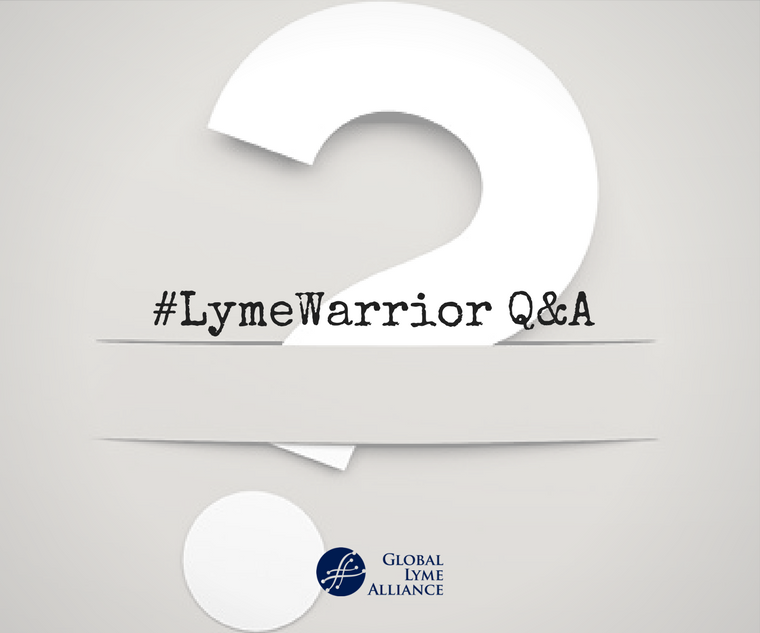
By Jennifer Crystal
Every couple months, Lyme Warrior Jennifer Crystal devotes a column to answering her readers’ questions. Here are her answers to questions she is frequently asked.
I found a bullseye rash, but my doctor thinks I should I wait until I have symptoms before starting treatment. Do you agree?
No. A bullseye rash is a telltale sign of Lyme disease. Symptoms can take weeks, months, or even years to develop, and by that point, the infection will be so advanced that it will require much longer treatment than it would have at the onset. With tick-borne disease, I always recommend erring on the side of caution. Had I been treated when I discovered my atypical erythema migrans rash (a blotchy series of red dots), my illnesses would not have become chronic and I would not still be dealing with them 20 years later.
In addition to being treated for Lyme, you should also be tested for co-infections. If your doctor is not a Lyme Literate Medical Doctor (LLMD), it’s important that you find one who is. You can find someone in your area through GLA’s “Find A Medical Professional” link.
What helps with brain fog?
Brain fog is one of the most frustrating symptoms of neurological tick-borne disease. It feels like your brain is filling with cotton. In addition to pressure and headaches, this feeling manifests in slowed thinking memory loss, difficulty coming up with words or a tendency to scramble word order. At my worst points, brain fog made it impossible for me to write, watch TV, or spend time on a computer.
For me, the biggest factors in eliminating brain fog were time and rest. I needed to give the antibiotics time to work. Due to Herxheimer reactions, my neurological symptoms got worse before they got better, but they did improve in time. You didn’t get sick overnight, and you aren’t going to get better quickly, either. As tough as it is, try to remember that you are a patient: your job literally is to wait, to give your body and brain the time they need to heal.
Sleep helps tremendously with brain fog, but insomnia is also a major symptom of neurological Lyme disease. Once I started getting more restorative rest—which I achieved through a combination of antibiotic treatment, sleep medication, and neurofeedback sessions—my brain fog decreased. It still flares up when I push myself by reading or writing for too long, watch an action-packed movie, or spend time in a crowded and loud environment.
You will have to learn your own limits, and be willing to abide by them. I avoid loud parties or concerts, and sometimes have to put down a book or walk away from a TV show even when I don’t want to. It’s hard to be strict with yourself, but it’s worth it to avoid brain fog.
My doctor wants to put a PICC (Peripherally Inserted Central Catheter) line in and start intravenous antibiotics. That’s a very scary thought to me. What are your thoughts on doing IV?
While only you and your LLMD can decide the best course of action for your particular case, I can tell you about my own experience with a PICC line. When I was initially diagnosed—eight years after being bitten by a tick—my doctor had me try oral antibiotics for three months. My improvement was very slow. My doctor then recommended a PICC line, for two reasons. First, the intravenous antibiotics would kill the disease bacteria faster, and, second, they would also take pressure off my stomach since oral antibiotics can have a number of abdominal side effects associated with them.
Like you, I was very scared to try this option, but I’m glad I did. A nurse at my doctor’s office put the line in, and it didn’t hurt any more than having a regular IV inserted. I had a chest x-ray at a hospital to make sure that the PICC was correctly aligned with my heart, and then did my first dose back in the doctor’s office to make sure everything went smoothly. These steps helped me to feel safe. The nurse taught me how to infuse my antibiotics and clean my line so I was comfortable with the process before I left the office. He then came to my house once a week to change my dressing and take blood. You’ll want to make sure your doctor has all these steps in place for you, too.
Having a PICC line can be frustrating because you can’t get it wet. I wore a special sleeve when I did dishes, took baths, or had someone wash my hair a sink. You also have to think about covering your line when you’re out and about. Those issues aside, I sometimes forgot I had the PICC line in at all. I used it for almost a year, and can say for sure that it made a positive difference in my recovery.
It’s important to know the risks associated with intravenous antibiotics, including the fact that some medications can cause gallstones (this happened to me). So be sure to talk through all the pros and cons with your LLMD, follow instructions carefully, and have a nurse come once a week. Having a PICC line can be very helpful but all safety protocols must be observed.
 Opinions expressed by contributors are their own.
Opinions expressed by contributors are their own.
Jennifer Crystal is a writer and educator in Boston. She is working on a memoir about her journey with chronic tick-borne illness. Do you have a question for Jennifer? Email her at jennifercrystalwriter@gmail.com

GLA
Admin at GLA






-2.jpg)